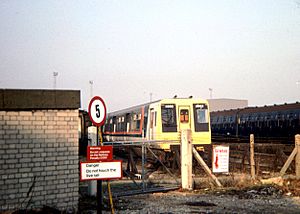British Rail Classes 445 and 446 facts for kids
Quick facts for kids British Rail Class 445 and 446 |
|
|---|---|

4PEP unit No.4002 in the sidings at Wimbledon depot
|
|
| In service | 1971-1980 |
| Manufacturer | BREL York |
| Family name | 1972 design (PEP) |
| Number built | 2 Class 445, 1 Class 446 |
| Formation | 2/4 cars per trainset |
| Capacity | 280 (445) 136 (446) |
| Operator(s) | British Rail |
| Specifications | |
| Maximum speed | 75 mph (121 km/h) |
| Electric system(s) | 750V dc third rail |
| Track gauge | Standard |
The PEP Stock trains were special test trains used by British Rail in the early 1970s. They were built to try out new ideas for future electric trains. Think of them as "prototype" trains, meaning they were the first versions built to test new designs and technology.
These trains helped British Rail design its "Second Generation" electric trains. Three of these test trains were built. One was a two-car train, and the other two were four-car trains. British Rail gave them special numbers: Class 445 for the four-car trains and Class 446 for the two-car train.
Contents
What Were the PEP Trains?
The PEP trains were officially called "electric multiple units" or EMUs. This means they were powered by electricity and had their own engines built into the train cars. They didn't need a separate engine (locomotive) to pull them.
These trains were designed to be modern and efficient. They were part of a big plan to update Britain's railway system. By building and testing these prototypes, engineers could learn what worked well and what needed to be improved for future train designs.
Designing New Trains
The PEP trains were built by BREL York, a major train manufacturer at the time. They were part of the 1972 design family, which focused on creating better, more comfortable, and faster electric trains.
The different numbers of cars (two or four) allowed engineers to test how trains of different lengths would perform. This was important for planning future train services, as some routes might need shorter trains and others longer ones.
How They Were Powered
The PEP trains ran on electricity. They got their power from a "third rail" system. This is a special rail placed next to the main tracks that carries electricity. The train has a special shoe that slides along this third rail to pick up the power it needs.
The trains used 750 volts of direct current (DC) electricity. They were designed to run on the standard railway tracks used across most of Britain, known as "Standard Gauge."
Life as a Test Train
Because they were prototypes, the PEP trains were only in service for a short time, from 1971 to 1980. Their main job was to help engineers gather information and test new technologies. Once enough data was collected, the lessons learned were used to build the next generation of trains.
Even though they weren't in service for long, the PEP trains played a very important role. They helped shape the design of many electric trains that came after them, making train travel better for everyone.
Images for kids



